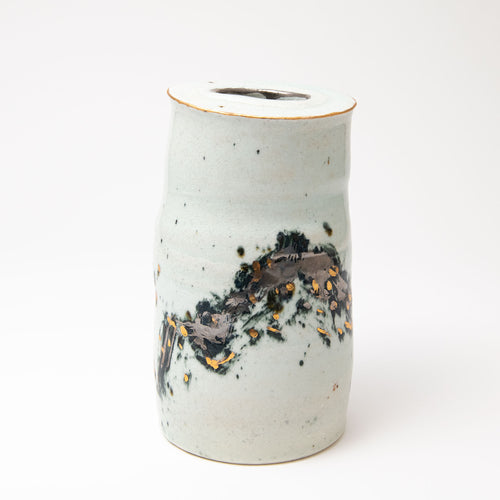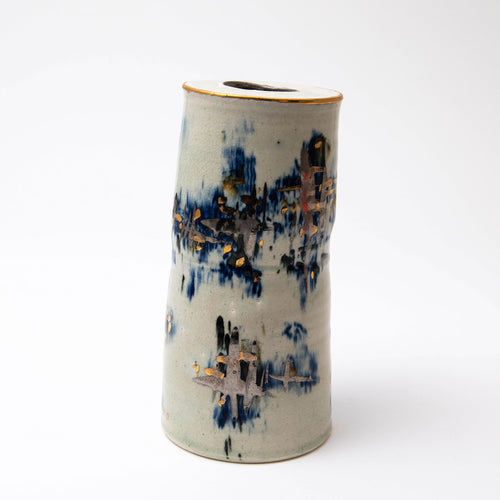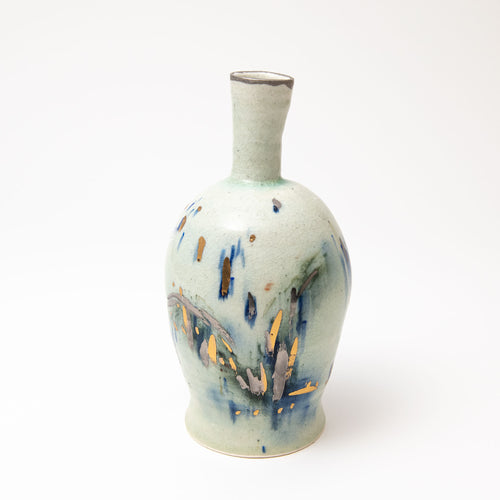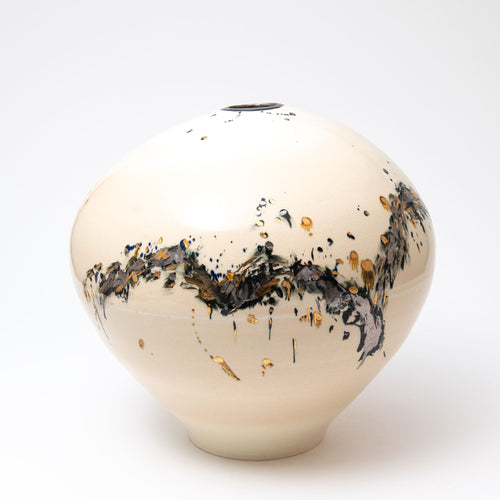Korea, Lee Kang-hyo tells us, is a country made of mountains, run through with rivers, and full of gentle curves. In these interview extracts we learn more about the country and landscape that has shaped Kang-hyo’s outlook and the inspirations behind his monumental Onggi jars and renowned buncheong pots.

Kang-hyo Lee at his studio in South Korea photographed by Jay Goldmark
Historically, the two Korean traditions in which you work and have modernised – Buncheong and Onggi – have been thought of as perhaps more rustic, and less refined or celebrated, than celadon or porcelain. What do they have to tell us about Korea, past and present?
A country’s art is often inspired by its landscape and Buncheong is a surface decoration developed uniquely in Korea, though it has since travelled elsewhere.
Korea is seventy percent mountains and has four seasons. Mountains, lakes and rivers make it a land full of gentle curves. Buncheong fits well in expressing our nature, which has no neat lines.

Kang-hyo Lee, Flat Bottle, Buncheong. Mountain water
This technique requires a dark clay body and decoration with white slip – the opposite of the landscape painter, with black ink and white paper. When I layer the white slip, I must consider its thickness and how it will melt in the fire, and how the iron will melt in the dark clay. Between the white and the black, I find many different grays – a spectrum mirrored in the natural world of mountains, wind, water, and sky.
When I started making pots as a student in Seoul I used to visit museums and taught myself by studying ceramics from the past. Korea has a very long ceramic history, but it was the traditional Korean big jar, called Onggi, that really grabbed my attention. They blew me away. When I looked at them, I never thought they were simply big jars. I saw great sculpture. I love their fullness of form and volume. So after university [Hongik University, Seoul] and my mandatory military service I went to an Onggi studio in south Gyeongsang, near Busan, to learn the traditional techniques.
Ceramic culture is very closely connected to dietary life and food culture. A lot of Korean foods are fermented and stored: soy bean sauce, chili paste, bean paste and kimchi might be kept in large jars for one, two, even three years at a time. It’s thanks to our diet and our cuisine that Koreans have developed the skills to make our Onggi jars. Mexico, Japan, China, Africa – many places have their own methods for making such pots. But to my mind, Koreans make the quickest and most perfect forms.

Kang-hyo Lee making a giant onggi jar at his studio in South Korea photographed by Jay Goldmark
This was not an easy time to be a student in South Korea, let alone an arts student. Chun Doo-hwan’s dictatorship was coming to an end and student-led protests and demands for democracy were still being met with violent suppression. But you were now about as far away from Seoul as you can get in South Korea – in fact you’ve said in the past that the workers at the Onggi workshop assumed you had left in order to avoid arrest.
Yes, that’s right. But those three years I spent at the Onggi studio were the foundation of my life as a potter today. I also got married during that time. My wife, Kyong Hee, studied ceramics at the same university as me. We had been going out since we were students and after I had been working for a year at the Onggi studio, we got married and she moved in. I didn’t have any money at that time. Korean brides used to provide ‘bottom drawer’ household items such as a wardrobe, refrigerator or cooker and so on. But our place was tiny and there was no room for any kind of furniture. Instead my wife brought some money to build an oil kiln. So we built a 0.5m3 oil kiln and prepared some other materials such as clay and glazes. On the weekends, I would throw some pots and Kyong Hee would decorate and finish them. That was our source of income. In fact, we’re still using the oil kiln that my wife bought. Now it is almost forty years old.
After I had trained with the Onggi master for three years and learned the various methods, I was in a dilemma. Technique is only technique. I had no idea how to start as an independent potter, nor did I have any money to set up my own pottery. So I worked as an assistant for my university teacher, Shin Seung-Ho, over three years in order to earn a living. I used to make large simple sculptures, about two metres tall, using the Onggi technique. Then I thought I should start to make my own work. So I came here. That was the beginning of my working life as a studio potter.

Kang-hyo Lee, Flat Bottle, Buncheong. Sky
Your wife and now your daughter have been a constant in your working life since then – I understand your daughter is a potter too.
My family, my daughter and my wife – they are absolutely essential for my existence. In the past, I felt like the important things were far away from me. I worked and thought hard, too hard, every day in order to get closer to those important things. But I soon realized that these were actually close by, and what I was really working for was a beautiful life. When I get tired from my work, they cheer me up; sometimes they look at my work and critique it. Now, in fact, my family is more important than my work: they give me so much love. Without it, I don’t think that I could ever have worked so hard and for so long a period of time.
My daughter makes ceramics as well. I always wanted to pass on the knowledge that I had accumulated over the years to my daughter, but her life is her own and I’d never force her to do what I have been doing. This way of working, and of living, isn’t easy. I didn’t want her to work with clay unless she wanted to. One day, when she was a high school student, she decided she wanted to study art, and I was quietly pleased. I have been watching her for a while. I think she has a good energy and the right mind for it, so I’m supporting her – but I don’t want to be involved in her work. My daughter’s life is hers. I watch and give a little help as a parent might. Then, she can mature and find her own way.
You have described in the past how the Japanese potter Koie Ryoji helped you to mature and to ‘free’ your own work. How did you meet him and what was he like?
I met him when I was 37 at an international ceramic workshop in Korea. At that time, between the ages of 35 and 45, as a potter making traditional Onggi and Buncheong I was often invited worldwide to give talks and demonstrations of these techniques. After this workshop, I visited his studio in Japan and we drank and talked together. Before I met him, I had a fairly conservative mindset, but Koie was more open-minded, very free and creative. He felt I was too dependent on my technique and that my work was a little bit tight.
One time I made a base for an Onggi form and decorated it with white slip. He appeared and said: ‘Kang-hyo, why don’t you try to change your thinking?’ He lifted the base up and crushed it. ‘The form doesn’t always have to be straight,’ he said: ‘It can be beautiful.’ That was his advice: to free myself. He reminded me that the brain is a pliable material, that it is flexible and can bend. Ever since then, keeping my mind open and flexible has been a lifetime goal.

Onggi support squashed by the Japanese potter Koie Ryoji in Lee Kang-hyo’s studio
There is plenty new to see in this exhibition since your last Goldmark show in 2017: what looks like metallic brushwork and many works in porcelain, a beautiful but notoriously testing material. Have you enjoyed working with this new medium?
Recently, I have been experimenting more and more with porcelain. For me, the technical challenges are really no different, since I have been working with clay for so long now. What I particularly enjoy is experimenting with these different surface and colour possibilities. For example, I have been using cobalt and black stain as a base topped with gold and silver paint. This contrast feels very expressive on the white clay body of porcelain, as if it were capturing my inner energy.

Kang-hyo Lee, Golden Long Bottles, porcelain
They’re certainly more ‘painterly’ than many of the pots at your last show here: more brushwork, more landscapes and trees, more calligraphy. Would you have liked to have been a painter?
I do enjoy painting – perhaps for my next show I will exhibit a painting. But I use ceramics as tools of living. I have made my life from ceramics and I draw my life on ceramics. This practice expresses my life. When I make pots, I use clay as a medium but it all comes through me and out of my body. My hands, my heart, my head. When I make a big jar or a small cup, no matter the form, I am contained. And I express myself differently depending on what kind of energy I have when I make each pot. The properties of clay as a material meets Lee Kang-hyo the human and maker. That energy is then delivered to my work and the two are linked inseparably. My work and I are presented equally.
You sometimes decorate to the sound of ‘Samul Nori’ – music that once celebrated the harvest rituals of the past. What is it about Samul Nori that moves you?
Samul Nori is a traditional Korean percussive music using four different instruments. This is powerful music that awakens the energy of things. When I make the huge jars and use Buncheong decoration, I feel I borrow this energy for my process. In less than ten minutes, I decorate a two-metre jar. It is an intense technique and feeling. During my slip performance, I dance and breathe with Samul Nori’s energy. In that moment, I feel only action exists, just me and the jar.

Is it difficult to share that experience with a public audience? It sounds very personal, very intimate.
When I perform in front of an audience, I also become one with that audience. In fact when I work at my own studio, I usually don’t listen to music. I prefer silence – but I feel like I become one with the silence as well.
Earlier this year you showed in an exhibition in Hong Kong called Ode to the Moon. The moon has an important place in Korean culture, celebrated in harvest festivals and by potters themselves in the form of the Moon Jar. What significance does it hold for you?
Traditionally, we use the lunar calendar instead of the solar calendar. I like the moon’s lyrical nature compared to the intense sun. When I see a crescent moon, I feel more comfort than in a perfect round shape; like our lives, there are always times of waxing and waning.

Korean Mountain Range
Your larger pots often have names: The Sky, Forest, Wind, Wild Flower, Tree of Life etc. You have also made some extraordinary ‘Mountain Water’ forms for this exhibition – sculptures of a kind we have never seen before. What is the significance of these elements of the natural world for you?
When I was 40 years old, I became very physically tired, and began to question and think about myself: Who am I? I was unhappy, so I left home to reflect on my life. There is a meditation group on Gaya mountain, an area three hours south of where I live, where I spent two and a half months. I left my home, my wife and my daughter, and I went to the mountain to find myself. It became a turning point for me. I have been thinking about the relationship and the balance between my work and my life ever since. So I live in the moment, and try to express in the moment what I see and feel.

Kang-hyo Lee, Mountain Water, Buncheong
Little has changed for me in the past five years since my last exhibition, but beautiful things exist all around me and they never get old. In front of my studio I can always see mountains, forest, river, sky. Nature exists by itself and its energy is expressed through my hands. Let me explain that a little more. There is a quiet energy, but there is also a very strong energy, like a storm. We can move quietly, but we can also run very fast. It is the same when I am making pots. Sometimes when I am building up a pot with coils and a paddle, I paddle really hard: that is a strong energy. Sometimes, I play music while I draw and paint on my pots: this gives me a powerful energy. And sometimes, I take energy from the sky, which is very quiet and slow. There is no difference between the quiet and the strong energy. I have both.
Max Waterhouse in conversation with Kang-hyo Lee, 2022










